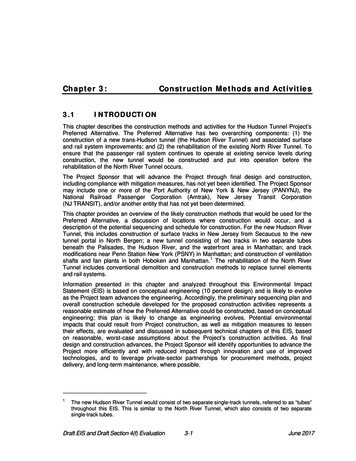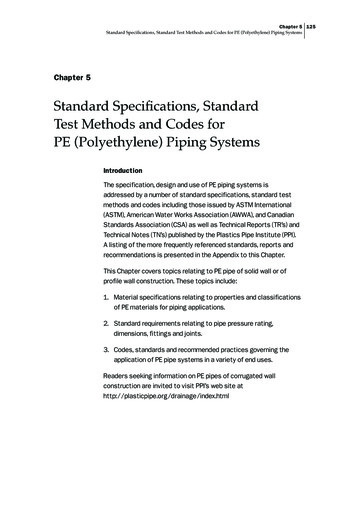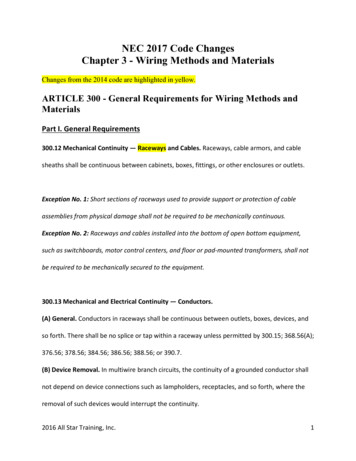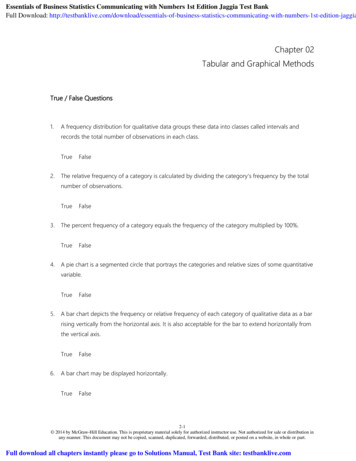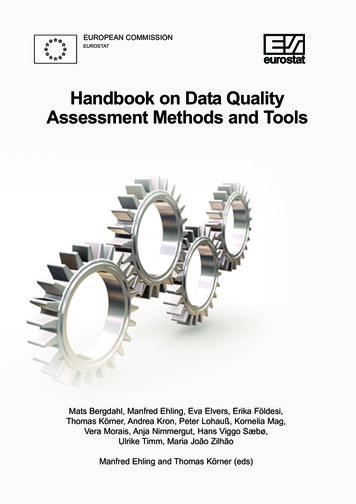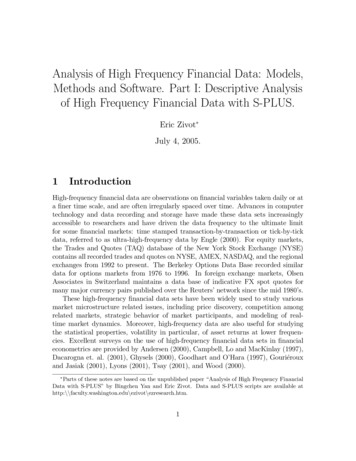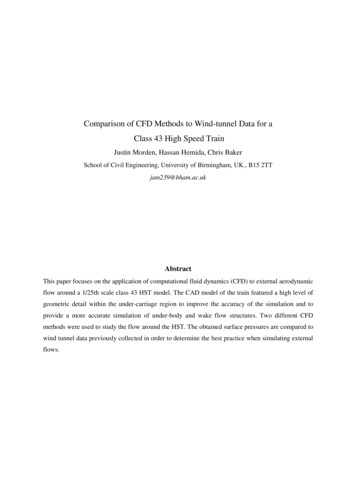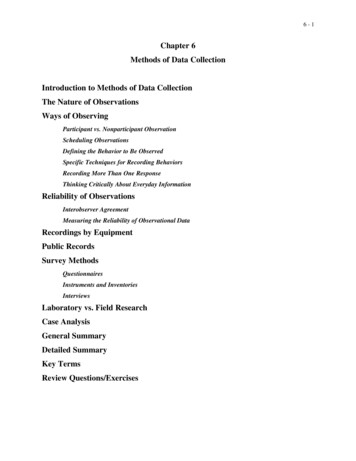
Transcription
6-1Chapter 6Methods of Data CollectionIntroduction to Methods of Data CollectionThe Nature of ObservationsWays of ObservingParticipant vs. Nonparticipant ObservationScheduling ObservationsDefining the Behavior to Be ObservedSpecific Techniques for Recording BehaviorsRecording More Than One ResponseThinking Critically About Everyday InformationReliability of ObservationsInterobserver AgreementMeasuring the Reliability of Observational DataRecordings by EquipmentPublic RecordsSurvey MethodsQuestionnairesInstruments and InventoriesInterviewsLaboratory vs. Field ResearchCase AnalysisGeneral SummaryDetailed SummaryKey TermsReview Questions/Exercises
6-2Introduction to Methods of Data CollectionBy now, it should be abundantly clear that behavioral research involves the collection of data andthat there are a variety of ways to do so. For example, if we wanted to measure aggressivebehavior in children, we could collect those data by observing children with our eyes, by usingequipment to measure the force with which they hit an object, by examining juvenile crimerecords, by surveying parents and teachers, by interviewing parents and teachers, or byadministering an aggression scale to children. This is just a sample of the methods that arepossible; we are sure that you could imagine many others. However, these examples do illustrateseveral distinctly different methods that can be used to collect data. As with most research designtechniques, each method has advantages and limitations. Perhaps the most interesting andchallenging of these is the method of observation. (In a sense, all of behavioral research is basedupon observation. What we describe here is a specific kind of observational procedure.)Historically, behavioral research has relied heavily on this method, and it will undoubtedlycontinue to be a primary method for gathering behavioral data. Let’s begin this chapter bydiscussing the nature of observations, the ways to make observations, and the reliability ofobservations. Following this discussion, we will turn to other methods illustrated by theexamples above.The Nature of ObservationObservations involve the use of our sensory systems (including eyes and ears) to record behavior. Theyrequire that humans make judgments about the occurrence of the behavior, its frequency, its duration, orits latency. These measures are the basic data used to describe naturally occurring behavior or to assessthe effects of our independent variable. Therefore, they must be gathered with care. Observations such asthese (judgments that behavior has or has not occurred) are inherently more subjective than other datacollection procedures. Because judgments are based on our perceptions, the same event occurring in theenvironment will be perceived differently by different people. We may observe Johnny chasing Maryaround the playground and call it aggressive behavior. You may observe the same event and call it playbehavior. Certainly, attention is one important factor. I may be attending to the conversation between twopeople, and you may be attending to the body language exhibited by those two people. As a result, wemay interpret our observations similarly or differently.Behavior measures based upon response categories such as play, aggression, and self-assertion aremore complex than specific responses such as talking, walking, or attending. These, in turn, are very
6-3different from the lever press, the key peck, heart rate, latency to respond, or eye blink responses. Therecording of these behaviors is usually automated, and there is little doubt about the criteria used for theiroccurrence or nonoccurrence. They do not require the judgment of human observers.Data derived from human observers are playing an increasingly important role in research,particularly in applied settings. They also play an important role in some laboratory settings. As youknow, the interests of psychologists are extremely varied. This broad scope of interest has resulted instudying behavior under a wider variety of conditions than in the past. Some studies involve makingunobtrusive observations of animals behaving in their natural settings, including primates and animalslower on the phylogenetic scale. Psychologists often record laboratory observations in addition to thebehavior that is automatically recorded. These observations are often interesting behaviors in their ownright. Applied psychologists sometimes encounter special problems. For example, behavior modificationexperts must be adept at recognizing when a given behavior achieves criterion (for example, when thesound made by a mute autistic child is sufficiently close to “mama” to warrant rewarding the child).Moreover, observers must be able to make fine distinctions between behaviors that are closer and moredistant approximations to the criterion behavior. Similarly, those studying the effects of psychologicallyactive drugs must attend to a wide variety of both specific responses and broader classes of behavior.Reliable observations are essential in assessing the treatment effects. In many instances, the primary andoften the only data are derived from direct observation by the investigators. It is essential that theseprimary data be accurate, objective, and reliable.In this chapter, we will discuss some problems associated with using human observers and somefactors that decrease the accuracy and reliability of observations. We will also discuss some ways ofassessing interobserver reliability. You should be aware that the method of observation does not apply toonly some research designs. In fact, all of the research designs discussed in this book, both experimentaland nonexperimental, can involve observation. One specific type of nonexperimental design, naturalisticobservation, always involves observation; it will be discussed in Chapter 15.Ways of ObservingParticipant vs. Nonparticipant ObservationThere are two broad approaches to observing behavior: participant observation and nonparticipantobservation. Participant observers conduct their observations “from the inside”; that is, the researcher isan integral part of the environment being observed. Nonparticipant observers conduct their observations“from the outside”; the researcher does not interact with those being observed.The following extract describes the habituating techniques used by Jane Goodall to study themountain gorilla in its natural habitat:
6-4My technique of habituating the gorillas was simple but essential, for I could only obtain unbiaseddata on their behavior if they remained relatively unaffected by my presence. I usually attempted toapproach the group undetected to within about 150 feet before climbing slowly and in full view ofthe animals onto a stump or the low branch of a tree where I settled myself as comfortably aspossible without paying obvious attention to them. By choosing a prominent observation post notonly was I able to see the gorillas over the screen of herbs, but, reciprocally, they could inspect meclearly, which was the most important single factor in habituating the animals. Under suchcircumstances they usually remained in the vicinity to watch me, and even approached me to within5 feet. (Schaller, 1963, p. 22)This description of Jane Goodall’s methodology suggests that she was a nonparticipant observer.However, if you are familiar with her work with gorillas, you know that the gorillas not only habituated toher presence but later began to interact with her. At this point, she became a participant observer.Let us imagine that we want to observe 9-year-old children on the playground and that we want torecord frequency of aggressive behavior. After establishing an operational definition of aggressivebehavior, we must decide how the observations will be made. Several options are available. As aparticipant observer, you could play with the children on the playground and make them aware that youare observing their behavior. Another option as a participant observer is to play with the children on theplayground without making them aware that you are observing their behavior. A third option is to be anonparticipant observer, observing the children “from a distance” and making them aware that you areobserving their behavior. A final option is to be a nonparticipant observer, observing the children “from adistance” without their awareness. Note that “from a distance” may refer literally to a geographic distanceor may represent a method such as a one-way mirror or a hidden camera. So, which method would youuse? If you are already considering the pros and cons of each approach, then you are thinking like abehavioral scientist!Whether you are observing gorillas in the rainforest or children on the playground, you will probablynot be able to observe them continuously. Scheduling observations is therefore an importantconsideration.Scheduling ObservationsDecisions must be made regarding frequency, duration, and time of day for scheduling observations.These decisions depend upon the purposes to be served by the observations. Researchers may only beinterested in a restricted, narrow time period, or they may be interested in a broad, representative time
6-5period. If you are interested in a representative description of naturally occurring behavior, it is necessaryto observe over many different time periods and across several days. Jane Goodall’s description ofprimate behavior under natural conditions is an excellent example. Laboratory studies, in contrast, oftenfollow a rigid schedule in that the experiment takes place at the same time each day for an hour or more.In this case, the observation period is confined to the laboratory session time. An applied program wouldfollow a different approach. A behavior modification program dealing with disruptive and unrulybehavior in social settings would require that observations be made in each setting where the disruptionsoccur. Whatever the purpose of the observations, individual observation sessions should be sufficientlylong to provide an adequate sample of the response of interest. Behaviors that occur with a low frequencymay require longer observation periods than high-frequency behaviors. For some purposes, it may benecessary to sample a behavior at different times during the day to determine its range and variability. Formost studies, however, observations are made at the same time each day so that observations are madeunder similar conditions from day to day.If the occurrence or nonoccurrence of complex behavior is being judged, the criteria for establishingthe presence of this behavior must be established. Before the behavior is recorded as present, these criteriamust be satisfied. To minimize the observer’s drifting away from the originally established criteria, aperiodic review should be scheduled during the course of observing. Although observer drift has been aproblem in some studies, it is usually correctable.Defining the Behavior to Be ObservedAs we have noted, our concern is to make observations that are both objective and reliable. We want tomaximize “pure” observations and minimize the degree to which our observations are affected by ourown interpretations and inferences. To this end, we attempt to define the dependent variable (behavior) interms of specific observable responses and to specify clearly the criteria for judging when the behaviorhas occurred. As discussed in Chapter 5, we need clear operational definitions for behaviors to beobserved. This is an important step if we are to ensure that different observers make similar observations.A good response measure will have relatively high interobserver agreement. The more precise we are inspecifying our definition of a response or of the behavioral criteria, the higher the interobserver agreementwill be. For example, if we were interested in the self-mutilating behavior of an autistic child, it would beunsatisfactory to instruct the observers to record every instance of self-mutilating behavior. The term istoo broad, abstract, and undefined to be useful or to assure agreement among observers. However, if weoperationally defined self-mutilating behavior as “head banging,” “biting one’s body,” or “beating oneselfwith fists,” we could more easily and reliably measure this class of behavior. Similarly, if observers areinstructed to record incidents of children’s aggressive behavior on the playground, one observer’s
6-6perception of aggression could be quite different from another observer’s perception of aggression.Again, an operational definition is needed so that we know specifically what is being measured.Specific Techniques for Recording BehaviorsConsider the following. A research team is interested in observing the self-mutilating behavior of childrendiagnosed as autistic. Having decided on a satisfactory operational definition of the target behavior, theteam must now decide on the observational technique to use. Three choices are commonly available: (1)count the number of occurrences of self-mutilating behavior during an observational session (frequencymethod); (2) record the period of time during which the target behavior lasts (duration method); or (3)break the observational sessions into equal time intervals and record the occurrence of self-mutilatingbehavior within each interval (interval method). Let’s take a closer look at each technique.Frequency Method. The frequency method of observation is simple, straightforward, and easilyunderstood. The observer simply counts the number of occurrences of the behavior of interest in a giveninterval of time. The interval of time is arbitrary; it may be as little as a few minutes or as much as severalhours. Further, it may be based on one observation session, or it may run across many sessions overseveral days. Often, the investigator is only interested in the frequency of the observations in a givensession and not in changes that may occur during that session. However, when the interest centers onassessing change or obtaining interobserver agreement within a session, the session may be divided intosmaller, equal time intervals. For example, a 60-minute session may be divided into ten 6-minuteintervals, and changes in frequency can be observed across this entire interval. Usually, observationperiods are of the same duration from day to day. If not, then comparing frequencies based on 15 minuteswith those based on 30 minutes would not be appropriate. If different durations are used, it is necessary toconvert frequency to response rate. This measure can easily be derived by dividing the frequency of theresponse by the unit of time—for example, responses per minute. The frequency method of recordingobservational data is most appropriate with discrete responses that take a relatively constant period oftime to complete—for example, number of cigarettes smoked, number of words spoken, or number ofhead-banging incidents.Responses occurring over long periods of time would not be appropriate for the frequency method.Responses such as time spent talking, sleeping, eating, or observing would be inappropriate. Countingthese observations would be wasteful of information, and counting their frequencies might not be asensitive way to assess a treatment effect. For these responses, the duration method is more appropriate.Frequency measures, particularly rate measures, are popular among psychologists interested in theexperimental analysis of behavior. In applied settings, attempts are often made to modify both excesses
6-7(such as fighting) and deficits of behavior (such as not talking). In these settings, monitoring frequency isobviously important. Moreover, frequency and rate measures have been shown to be sensitive tocontingencies of reinforcement.Duration Method. As we noted, in those instances where response duration is long and/or theoccasions of its occurrence relatively infrequent (such as sleep or inactivity), it is usually inappropriate torecord frequency. Instead, we want to measure the duration of the response. For example, using theduration method of observation, we might measure the duration of time spent either in solitary or insocial activity. Using a stopwatch or an event recorder, the observer activates the instrument when the behavior begins and terminates the time recording when the behavior ends. Even though response frequencyis not of primary interest, it is possible to obtain a frequency measure by simply counting the number oftimes the recording instrument was activated. Judging when a response is initiated or terminated can oftenbe difficult. For example, imagine you are studying the talking of an autistic child. There may be manypauses of varying duration, brief interruptions, or changes in the intensity of the behavior that requires ajudgment as to whether a different response occurred. It is important that another observer (interobserveragreement) be able to make similar observations. Consequently, the decisions must be made as objectiveas possible.Interval Method. The interval method of observation is the most flexible and widely usedrecording method. This method permits the recording of any behavior, whether discrete (head banging) orcontinuous (sleeping). With this method, the observation period is broken into equal intervals, the size ofwhich varies with the particular observations of interest. Behavior is recorded as occurring (yes) or notoccurring (no) in each interval. The interval size may be as short as a few seconds or as long as a fewminutes, depending on the behavior under observation. A desirable time interval is long enough toaccommodate a single response but not long enough to accommodate more than one response. Researchinterest is focused on the number of intervals during which the response occurs. For high-rate, shortduration responses, the interval should be short so that no more than one response per interval will occur.If more than a single discrete response can occur per interval, then counting the intervals mayunderestimate the frequency of the observed behavior. In contrast, if the intervals are so short that a singleresponse can fall into two or more intervals, counting the intervals in which a response occurs mayoverestimate the frequency of behavior.Obviously, the criterion for occurrence or nonoccurrence of behavior must be clear so that itsoccurrence can be quickly and reliably determined. The problem is more difficult than it at first appearsbecause only a portion of the behavior may occur in a given interval. It becomes even more difficult if the
6-8observer is recording several different responses concurrently. When this happens, a decision rule issometimes adopted; if a response fills one-half or more of the interval, it is scored as occurring in thatinterval. For continuous responses (such as talking), each interval in which talking occurred would bescored as an occurrence. Therefore, the interval scoring method allows the investigator to derive bothfrequency (discrete responses) and duration (continuous responses) data.Recording More Than One ResponseWith the interval method, it is common to score several different responses that occur concurrently in aninterval. When this is done, it is essential to reserve time at the end of each interval for recording whetherthe different behaviors occurred. We will first give an example of scoring one response across differentparticipants. Then, we will give an example of scoring multiple responses.Let us assume that our observational period will be daily 30-minute sessions and we are interested inthe occurrence or nonoccurrence of a single behavior. We decide that an interval size of 30 seconds isappropriate for our response. Therefore, we would divide the 30-minute session into 60 30-secondintervals. For each of these 30-second intervals, we would record whether or not the behavior occurred. Ifwe were observing three participants, our scoring sheet would look li
its latency. These measures are the basic data used to describe naturally occurring behavior or to assess the effects of our independent variable. Therefore, they must be gathered with care. Observations such as these (judgments that behavior has or has not occurred)are inherently more subjective than other data collection procedures.

